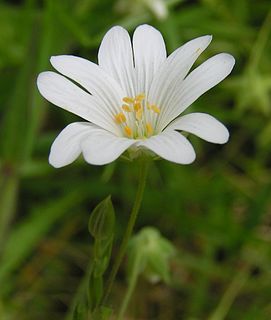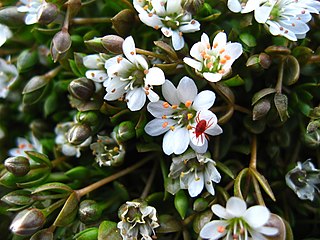
Stellaria is a genus of about 90-120 species flowering plants in the family Caryophyllaceae, with a cosmopolitan distribution. Common names include starwort, stitchwort and chickweed.

Stellaria graminea is a species of flowering plant in the Caryophyllaceae family known by the common names common starwort, grass-leaved stitchwort, lesser stitchwort and grass-like starwort.
Stellaria crassifolia, the fleshy starwort, is a plant of the Stellaria genus and is found in northern North America, Europe, and Asia. Its common Icelandish name is "Stjörnuarfi" (star-weed).

Stellaria humifusa, the saltmarsh starwort, is known in Iceland as "Lágarfi", and grows only in beach areas.

HMS Lotus was a Flower-class corvette that served in the Royal Navy.

Callitriche marginata is a species of aquatic plant known by the common name winged water starwort.

Callitriche is a genus of largely aquatic plants known as water-starwort. Previously, it was the only genus in the family Callitrichaceae. However, according to the APG II system this family is now included in the Plantaginaceae. The family name Callitrichaceae retains its status as nomen conservandum.

Pseudostellaria jamesiana is a species of flowering plant in the pink family known by the common names tuber starwort and sticky starwort. It is native to much of the western United States, where it can be found in sagebrush, coniferous forests, and many other types of habitat. It is a perennial herb growing from a rhizome network with tuberlike swellings. The stem grows up to 45 to 60 centimeters in maximum height. It is four-angled and usually at least partially coated in glandular hairs. The thick lance-shaped leaves are up to 15 centimeters long, oppositely arranged, and sometimes rough and hairy. The inflorescence is a cluster of flowers at the tip of the stem or in the leaf axils. Flowers occurring in leaf axils are sometimes cleistogamous, never opening. Open flowers have five white petals with two lobes at the tips and usually ten long stamens.

Pseudostellaria is a genus of flowering plants in the pink family. There are up to 20 species, most of which occur in Asia. They are similar to Stellaria, differing in the morphology of the roots and fruit capsules and having shallower notches in the petals.
Stellaria crispa is a species of flowering plant in the pink family known by the common names curled starwort and crisp starwort. It is native to western North America from Alaska south to California and Wyoming, where it grows in moist, shady habitat such as deep forests and streambanks. It is a rhizomatous perennial herb producing a mat of prostrate or trailing stems up to about 40 centimeters long. It is lined with opposite pairs of pointed oval leaves each 1 to 2 centimeters long. Single flowers occur in the leaf axils, each borne on a short pedicel. The flower has five pointed green sepals each a few millimeters long. Some flowers have one or more petals, but most lack these.

Stellaria longipes is a species of flowering plant in the pink family known by the common names longstalk starwort and Goldie's starwort. It has a circumpolar distribution, occurring throughout the northernmost latitudes of the Northern Hemisphere. It grows in a wide variety of habitat types, including tundra and taiga and many areas farther south with subalpine and alpine climates. It is extremely variable in morphology, its form depending on both genetic makeup and environmental conditions. It has a widely varying number of chromosomes. In general, it is a rhizomatous perennial herb forming mats or clumps, or growing erect. The stems may be short and simple or with sprawling and highly branched. The linear to lance-shaped leaves are usually 1 to 4 centimeters long and are oppositely arranged in pairs. The inflorescence bears one or more flowers, each on a short pedicel. The flower has five pointed green sepals each a few millimeters long. There are five white petals each divided into two lobes, sometimes shallowly, but often so deeply there appear to be two petals. The plant is gynodioecious, with some flowers having functional male and female reproductive parts and others being only female.

Stellaria obtusa is a species of flowering plant in the pink family known by the common names Rocky Mountain chickweed, blunt-sepaled starwort, and obtuse starwort. It is native to western North America, from British Columbia and Alberta to California to Colorado, where it grows in moist areas in forests and on mountain slopes.
Stellaria umbellata is a species of flowering plant in the pink family known by the common names umbrella starwort and umbellate starwort. It is native to western North America from Alaska and northwestern Canada to the southwestern United States, as well as parts of Asia, including Siberia. It grows in subalpine and alpine climates in mountain forests and riverbanks. It is a rhizomatous perennial herb producing a slender prostrate stem up to about 20 centimeters long, sometimes forming clumps or mats. The stem is lined with pairs of oval leaves each up to about 2 centimeters long. The inflorescence is an umbel-shaped array of several flowers each on an arching or erect pedicels. The flower has five pointed green sepals each no more than 3 millimeters long. There are occasionally tiny white petals within the calyx of sepals, but these are generally absent.
Callitriche antarctica, commonly known as the Antarctic water-starwort, is a small, prostrate plant with tiny yellow flowers in the plantain family. It is found in wet places on many subantarctic islands and has a wide circumantarctic distribution, something reflected in its specific epithet.

Cerastium cerastoides, the mountain chickweed or starwort mouse-ear, is a flowering plant species in the genus Cerastium found in the mountains of Europe.
Pseudostellaria oxyphylla, the robust starwort or Robinson's starwort, is a rare plant species endemic to Idaho, known only from Kootenai and Shoshone Counties. It grows along streambanks in conifer forests at elevations of 800–900 m.

Callitriche brutia, the pedunculate water-starwort, is a submerged/floating-leaved aquatic plant in the plantain family. It is found in aquatic environments in Europe.

Callitriche palustris, the vernal water-starwort, narrow-fruited water-starwort, or spiny water starwort, is a species of aquatic plants. It is the type species of its genus.
West's Meadow is a designated Site of Special Scientific Interest (SSSI) based in Berkshire in Aldermaston. The site is predominantly a grassland meadow.










